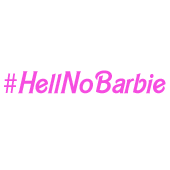
 While industry analysts predict Hello Barbie will be a hot toy this holiday season, Mattel’s new Wi-Fi enabled talking doll has become the subject of a public education campaign. Launched yesterday by Campaign for a Commercial-Free Childhood (CCFC), Hell No Barbie defines potential dangers of the latest incarnation of one of the world’s bestselling toys.
While industry analysts predict Hello Barbie will be a hot toy this holiday season, Mattel’s new Wi-Fi enabled talking doll has become the subject of a public education campaign. Launched yesterday by Campaign for a Commercial-Free Childhood (CCFC), Hell No Barbie defines potential dangers of the latest incarnation of one of the world’s bestselling toys.
At first glance, buyers may think Hello Barbie isn’t so different than Apple’s Siri. Parents might be glad to learn her thighs are slightly thicker thanks to the rechargeable batteries inserted here.
Look closely at this blue-eyed, blond-tressed doll before she becomes your child’s confidant. Press on Barbie’s belt buckle and a microphone inside the doll’s necklace activates. “Hello Barbie records children’s private conversations and transmits them to cloud servers, where they are analyzed by algorithms, listened to by employees of Mattel’s partner ToyTalk, and shared with unnamed third parties. The doll’s responses are then tailored to reflect the child’s family, experiences, and likes and dislikes,” says the CCFC.
 “Eight Reasons to Leave Hello Barbie on the Shelf” was created in consultation with child development, psychology, information technology and privacy experts:
“Eight Reasons to Leave Hello Barbie on the Shelf” was created in consultation with child development, psychology, information technology and privacy experts:
1) Children’s private conversations shouldn’t be shared with corporations or strangers.
2) Is Hello Barbie a “friend,” or a viral marketer?
3) Hello Barbie undermines creative play.
4) Surveillance has no place in children’s play.
5) Children deserve a genuine listener, not a robot.
6) Why let the Barbie brand have more influence over your child?
7) Even parents shouldn’t listen to secret recordings of their children.
8) Hello Barbie is vulnerable to data breaches.
In hopes of a viral backlash, the CCFC created shareable #HellNoBarbie images for social media.
“It’s really the combination of all these factors which make Hello Barbie a terrible toy,” says Josh Golin, the CCFC’s executive director. “We are extremely concerned about the potential for children’s private conversations to be misused for marketing purposes (#2). Ultimately, I think # 4 may be the most concerning. Hello Barbie encourages children to confide in and interact with a corporate surveillance device.”
In a recent New York Times Magazine article, writer James Vlahos shares a conversation between Barbie and a 7-year-old named Tiara who clearly didn’t like her sister:
Barbie forged ahead. ‘‘Well, what is the last nice thing your sister did?’’
‘‘She helped me with my project — and then she destroyed it.’’
‘‘Oh, yeah, tell me more!’’ Barbie said, oblivious to Tiara’s unhappiness.
‘‘That’s it, Barbie,’’ Tiara said.
‘‘Have you told your sister lately how cool she is?’’
‘‘No. She is not cool,’’ Tiara said, gritting her teeth.
‘‘You never know, she might appreciate hearing it,’’ Barbie said.
It’s potential doll/child dialogue like this that the CCFC wants the public to ponder. “Children playing with Hello Barbie get a host of messages about what they are supposed to think, what they should care about, and what sorts of responses are appropriate in conversation. If we never have to use creativity and imagination, we are unlikely to develop them and keep them working,” says Tracy Gleason, Ph.D., professor of psychology at Wellesley College.
What do you think?











